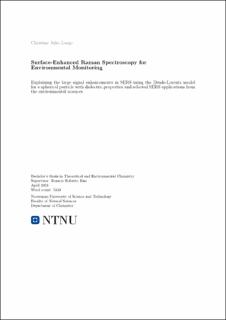| dc.contributor.advisor | Riso, Rosario Roberto | |
| dc.contributor.author | Lange, Christine Julia | |
| dc.date.accessioned | 2023-06-22T17:20:04Z | |
| dc.date.available | 2023-06-22T17:20:04Z | |
| dc.date.issued | 2023 | |
| dc.identifier | no.ntnu:inspera:146699659:47013886 | |
| dc.identifier.uri | https://hdl.handle.net/11250/3072756 | |
| dc.description.abstract | Prinsippene for overflateforbedret Raman-spektroskopi (SERS) blir utforsket med fokus på rollen den dielektriske responsen har i å modifisere det lokale elektriske feltet rundt en nanosfære. Drude-Lorentz-modellen brukes til å utlede et uttrykk for den komplekse dielektriske funksjonen med fokus på gull og sølv da disse er de to vanligste SERS-substratmaterialene. Noen tekniske utfordringer ved teknikken blir diskutert, spesielt fluorescerende interferens som delvis eller helt kan skjule Raman-signalet. Til slutt presenteres tre moderne eksempler på SERS-applikasjoner i miljøovervåking for å demonstrere noe av teknikkens praktiske bruk samt potensial for fremtiden. | |
| dc.description.abstract | In this thesis, the principles of surface-enhanced Raman spectroscopy (SERS) are explored with a focus on the role of dielectric response in modifying the local electric field around a nanosphere. The Drude-Lorentz model is utilized to derive an expression for the complex dielectric function, specifically for gold and silver as these are the two most common SERS substrate materials. Some technical challenges of the technique are discussed, especially fluorescent interference which can mask the Raman signal. Finally, three contemporary examples of SERS applications in environmental monitoring are presented to demonstrate some of its practical use and potential for the future. | |
| dc.language | eng | |
| dc.publisher | NTNU | |
| dc.title | Surface-Enhanced Raman Spectroscopy for Environmental Monitoring | |
| dc.type | Bachelor thesis | |
